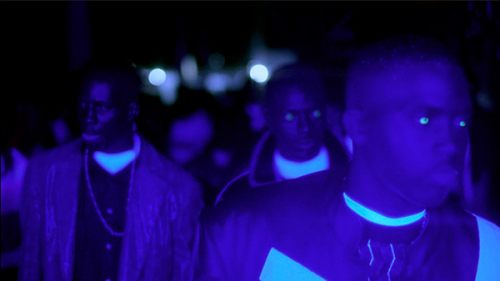In Defense Of BELLY
When people bring up the films Scarface and Fight Club, the conversation usually revolves around how fratbros and wannabe gangsters completely miss (or willfully ignore) the message, almost as much as it evokes comments about the technical craft, over the top performances, memorable scenes and entertainment value of the films themselves. When I think of these films, though, I think of how much 1998's Belly should be part of this conversation, but never gets its due. Perhaps because no one but a handful of black people saw it, and perhaps because, just like those aforementioned films, the message also went over most of the audience members' heads. The difference here being, since there's no Oscar buzz-worthy actors or esteemed director at the helm, people dismiss the film as trashy Blaxploitation. But that couldn't be further from the truth.
On paper, Belly is just another boilerplate crime drama about how a life of street crime can only end one way, where eventually even the mightiest must fall. But in its execution lies perhaps one of the greatest displays of style as substance in contemporary cinema. The movie was directed by Hype Williams, who gained notoriety throughout the nineties for an impressive body of work in hip-hop music videos. His cinematic acumen and use of tools and techniques such as fish eye lenses, wide ratio shots, tracking shots and starkly contrasting color palettes practically revolutionized the way music videos were made. Through the lens of Hype Williams, the stories of the streets were displayed to the world with a vibrancy like they had never been seen before. I believe that his work in visualizing the fantastic music of that era was nearly as important to the cultural explosion of hip-hop into mainstream culture as was the music itself. With his first (and only) feature film, he was able to bring all those cinematic, musical and street elements together into a highly polished kinetic collage. The opening scene of this film not only summarizes Hype's style and a lot of what the film contains, but remains among the most vivid and memorable opening sequences I've ever witnessed:
A lot of black movies in the '90s had the really annoying habit of shoehorning hip-hop and R&B artists into the scenes as ancillary or supporting characters, perhaps hoping that if the audience saw their favorite artists in the trailers, they would be more inclined to buy a ticket at the theater. Unfortunately, most of the artists, though talented in their respective musical fields, couldn't act themselves out of a paper bag, and the films suffered greatly from their inclusion. The genius in Belly's casting is that the two leads, hip-hop legends Nasir “Nas” Jones and Earl “DMX” Simmons, are essentially just playing themselves. While this might seem lazy on the surface, it's important to understand that the well-established musical personas of each artist - the hard yet wise street sage Nas and the unpredictably outspoken rough rider that is DMX - allow the audience to buy into their respective characters as the calm and calculated Sincere and the volatile live wire Bundy almost immediately.
Sincere provides most of the narration with a frame of reason and introspection, while the monstrous Bundy blazes through a violent path on his way to becoming the king of the streets, leaving death and destruction in his wake. I appreciate the effects of letting DMX absolutely maul the scenery in his own natural voice much more now after seeing him try “real” acting years later in the not-very-good martial arts joints Cradle 2 the Grave and Exit Wounds; in those he is ridiculously miscast and stilted. Not every rapper-turned-actor can be as good as Ice-T and Ice Cube, but no one, I think, could have pulled off the character of Bundy like DMX. Beyond the two leads, there are other musical artists in the film who actually do a decent-to-very-good job onscreen. Tionne Watkins (T-Boz of TLC fame) plays Sincere's wife, a voice of reason and stability in the mounting chaos. But the real pleasant surprise is seeing Clifford “Method Man” Smith, of the rap super-group The Wu-tang Clan, absolutely killing it in his role as the vicious hired muscle Shameek. In this, one of his earliest roles, you could see the workings of a real screen star, and he has proven himself in the years since in a list of respectable roles (most white people will recognize him from his most notable role as Cheese on The Wire). The musical casting reaches even greater thematic cohesion with the inclusion of Lenny Rankin, a well-renowned Jamaican dancehall reggae artist, as the Jamaican drug lord Ox. Most people remember “Say hello to my little friend!” as the go-to gangster quote, but for me, nothing will ever top a stoned out Yardie with a pearl finish AK-47 shouting “WHO WAN TEST ME?! I am the Original Jamaican Don Dada!!”
It should be stated outright that although Williams had a concise vision and the leading men were perfectly suited to enact the story, the film was plagued with production problems. The barebones script that they did have was subject to multiple rewrites, Hype butted heads with producers throughout the filming, some of the cast who were not used to the professional rigors of acting would show up drunk and/or late, if at all, and the already meager budget for what he had planned was cut about ¾ of the way into filming. Although a more discerning critic can spot out all the objective faults in the construction of the film because of those problems (Belly was critically savaged upon release), none of that ruined the movie for me. However, perhaps the greatest hurdle of all toward appreciating Belly is when the big message comes through at the end. Some would argue that the movie spends its entire time glamorizing brutal violence, obscene sex, gratuitous drug use and an overall nihilistic, self-destructive lifestyle that has led to the deaths of so many of my people, so much so that by the end of the film, any message against it is all drowned out in a haze of blunt smoke and blinding strobe lights. To me, the hip-hop music video style of glamorization was vital to the message.
It has always been strange to me how black youth appropriate the ideologies and aesthetics of an Italian-American playing a caricature of a Cuban immigrant, though no less strange is the appropriation of both Italian-American Mafia and South American cartel aesthetics into their street personas (Nas "Escobar", Beanie Siegel, Capone-N-Noriega, Jay-Z's earlier Mafioso persona and his Roc-la Familia crew moniker, etc...). Because of this, I think that in order for the message to really set in, it was important for the message to be re-contextualized with black faces using black words in a black setting to definitively show just how much of a hand we have in our own destruction. Moreover, when the end conceit comes, all the previous scenes of stylized criminal activity flash before our eyes, juxtaposed with the monologue of a minister character who is literally preaching to the audience why all this stuff is bad. It really is one of the most blatantly obvious “Ending Is the Conceit” finales I have ever witnessed, yet still it gets shrugged off as too little, too late.
I have been wrestling with a torrent of thoughts and emotions recently in the wake of the Ferguson, Missouri, shooting. This was just one of several articles I drafted up to help me work through them. One of the things I had to deal with was my stances about our own role in our continued survival. An unjust system has affected our very psyche as much as it has afflicted our mortal safety. I don’t wanna come off as another one of these DeVry bow tie professors trying to put some of the blame for this on ourselves. Rather, though the struggle continues, I think one important thing to remember is to not fall into the abyss of self-loathing and apathy. As Michael Brown's mother lamented; "Do you know how hard it was for me to get him to stay in school and graduate? You know how many black men graduate? Not many. Because you bring them down to this type of level, where they feel like they don't got nothing to live for anyway." For all its gaudiness, the message in Belly, about the struggle to overcome our sense of nihilistic despair, has always stuck with me. I hope that those out there who never heard of or never got a chance to experience this film the first time around will be able to appreciate it for what it attempted to do, flaws and all.
I really do fucking love this movie. It resonates with me on a very visceral and emotional, and somewhat personal, level; parts of the movie were filmed in my own neighborhood in Jamaica, Queens and the neighboring Hollis area. (I've been getting my haircuts at The Hut barbershop for years, which is the location of a scene where Sincere gets attacked....and which is also a block over from where Jam Master Jay of Hip-Hop Pioneers Run DMC was murdered.) While so much footage you see of The Hood in movies, TV, news and the papers portrays it as a drab, desolate, washed-out wasteland - and it definitely can be - I'm still amazed at how Hype Williams was able to use his cinema to portray what is often very hard for me to describe to others: in all our hard times, sorrow and danger, our home can also feel alive with color and vibrant with excitement. Moreover, as the years have passed and my finer appreciation of cinema has grown, I am able to recognize where my indulgence ends and thematic resonance begins. I hope others will be able to accept it on those merits as well.


